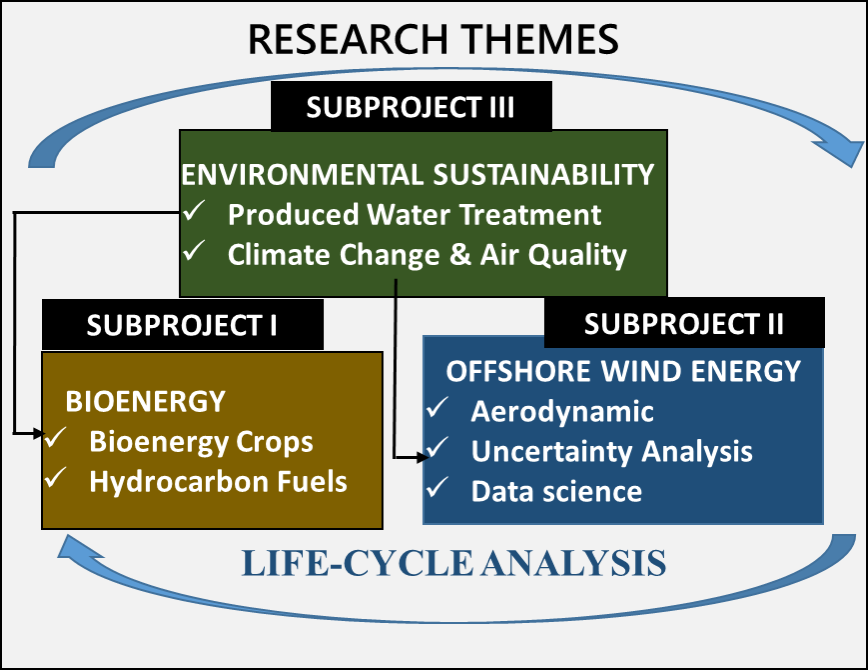
The U.S. energy sector is built on a complex mixture of fossil fuels, nuclear, and renewable fuel sources. As of 2017, renewable energy sources accounted for 12% of total US energy consumption, and 15% of total electricity generation. In the electricity production sector, natural gas and renewables are the fastest-growing sources. Petroleum (46%) and natural gas (29%) were the primary sources of the 5.14 billion metric tons of CO2 emitted in 2017, and electricity generation (34%) and transportation (37%) were the largest CO2-producing sectors. The research proposed in Phase II CEES will answer pivotal scientific questions that are key to reducing these energy-related CO2 emissions, increasing the sustainability of fossil fuel energy sources, and improving the technological efficiency of bioenergy and offshore wind energy.
Center research is organized into three subprojects (SPs). Subproject I (Bioenergy) will focus on the production of bioenergy crops with treated produced water and generation of biomass-based hydrocarbon fuels. Subproject II (Offshore Wind Energy) will conduct research to improve the feasibility and reliability of massive offshore energy generation. Subproject III (Environmental Sustainability) will employ process engineering and stochastic methods to enhance the sustainability of fossil fuel energy sources. These subprojects build on Phase I results while substantially expanding the research scope and leveraging collaborations with other universities, national labs, and industry.
The four overarching goals of Phase II:
- Address diverse global energy issues and answer pivotal research questions related to renewable energy and sustainability, positioning PVAMU’s renewable energy research program as a national resource.
- Enhance institutional capabilities of PVAMU by improving physical infrastructure, professionally developing key personnel, and sustainably supporting CEES research and education excellence.
- Expand collaborations within academia and strengthen partnerships with the energy industry, particularly in the Greater Houston area.
- Increase the preparedness and number of students from underrepresented groups who successfully complete degrees in STEM fields with a focus on Energy Engineering, to build a diverse workforce.
The U.S. energy sector is built on a complex mixture of fossil fuels, nuclear, and renewable fuel sources. As of 2017, renewable energy sources accounted for 12% of total US energy consumption, and 15% of total electricity generation. In the electricity production sector, natural gas and renewables are the fastest-growing sources. Petroleum (46%) and natural gas (29%) were the primary sources of the 5.14 billion metric tons of CO2 emitted in 2017, and electricity generation (34%) and transportation (37%) were the largest CO2-producing sectors. The research proposed in Phase II CEES will answer pivotal scientific questions that are key to reducing these energy-related CO2 emissions, increasing the sustainability of fossil fuel energy sources, and improving the technological efficiency of bioenergy and offshore wind energy.
